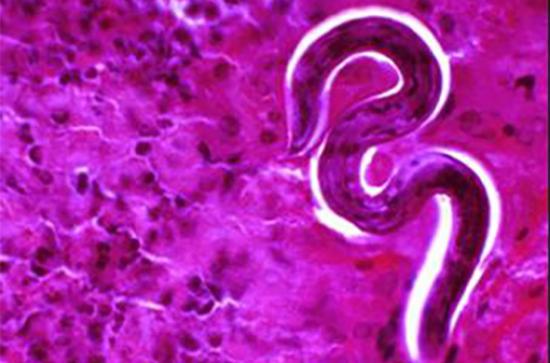
Scientists working out of Maynooth University, Trinity College Dublin, and Queen Mary University of London have unearthed a potential new preventative option to combat Ascaris roundworm infection. Ascaris lumbricoides is an intestinal parasite that confers severe health consequences, including growth retardation and impaired cognitive development. The infection, which affects an estimated one billion people worldwide, is particularly common in Third World countries and is estimated to be responsible for 60,000 deaths per annum.
Susceptibility to Ascaris infection differs between individuals, and heavily infected individuals have more severe symptoms and higher morbidity. Building on previous studies, , which showed a difference in susceptibility to Ascaris between two different mouse strains, Dr. Jim Carolan and Gwendoline Deslyper, of Maynooth University, Professor Celia Holland and Andrew Cooper, of Trinity College Dublin and Dr. Joe Colgan, of Queen Mary University of London, U.K. used a quantitative proteomics approach to study the differences between the two strains. They have just published their findings in the internationally regarded peer reviewed journal, PLOS Neglected Tropical Diseases, A Proteomic Investigation of Hepatic Resistance to Ascaris in a Murine Model, DOI:10.1371/journal.pntd.0004837. This work has highlighted the role proteins in the liver play in potential host resistance to the infection. It is thought that these new insights could lead to the development of better ways to prevent and treat Ascaris infection.
The lifecycle of the Ascaris roundworm in humans sees the infection progress from the stomach, following ingestion of viable eggs which hatch as larvae, to the liver before moving on to the lungs and then returning to the stomach. In mice, the roundworms do not progress beyond the lungs. Studies have shown that, in the resistant strain of mice, the larvae are ten times less likely to progress beyond the liver. Following infection with identical numbers of Ascaris eggs, mice from the resistant strain show an earlier inflammatory immune response coupled with more rapid tissue repair in the liver compared with susceptible mice.
The researchers set out to examine the differences in the composition of proteins in the two strains of mice. The researchers identified and quantified thousands of proteins and found that hundreds of liver proteins differed substantially between the two strains, even without Ascaris infections. The resistant strain showed generally higher levels of mitochondrial proteins, whose role in the immune system has been previously identified, and proteins involved in the generation of reactive oxygen species (ROS). Ascaris infection increased the level of these proteins in both strains, supporting the evidence of their role in the resistance to the parasite.
Other proteins were seen only in infected mice; these included proteins involved in a part of the immune response. Two of these proteins were absent from both strains before infection, but were among the highest expressed proteins in both strains following infection. Proteins involved in translation were of lower abundance in all infected mice livers, which suggests either a broad response in the host to the presence of Ascaris or a specific targeting of the protein synthesis machinery by the parasite itself.
Lead author Gwendoline Deslyper said: “Given our findings and the central role of the liver in the Ascaris migratory pathway, we suggest a potentially novel research direction to develop alternative preventative control strategies for Ascaris. It seems that the key determinant in resistance to Ascaris in mice may lie in highly oxidative conditions that presumably restricts and arrests successful larval migration within the hepatic environment – at least of the resistant strain.”
The proteomic study, which mapped the proteins of the affected organs, was led by Dr James Carolan, Maynooth University Department of Biology and Professor Celia Holland, School of Natural Sciences, Trinity College Dublin. Discussing the findings, Dr Carolan said: “There is still a long way to go and much research to be done, but these findings point to new options in our efforts to control a disease that affects around one eighth of our planet’s population. This is a very significant step forward and I am very excited to move ahead with next steps.”
- The proteomic study was led by Dr. Jim Carolan utilising the facilities of the Science Foundation Ireland and HEA funded Mass Spectrometry Unit in the Department of Biology, Maynooth University.
- The research was conducted primarily by Gwendolin Desylper as part of her MSc in Immunology and Global Health at Maynooth University. Gwen is currently awaiting notification of an Irish Research Council application to continue this exciting and important research.
Dr Joe Colgan is also a graduate of the MSc in Immunology and Global Health programme from Maynooth University. He is currently a post doctoral researcher at the School of Biological and Chemical Sciences, Queen Mary University of London.
